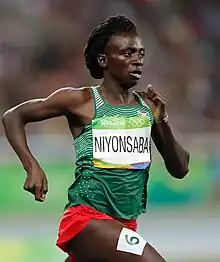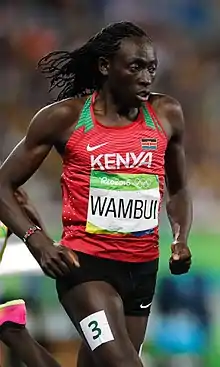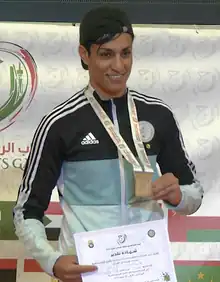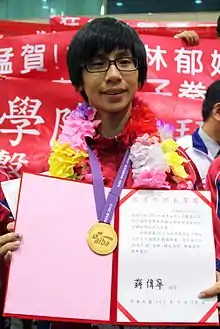| LGBTI Olympians and Paralympians |
|---|
 |
|
Lists of LGBT+ Summer Olympic athletes |
|
List of LGBT+ Winter Olympians; by debut |
|
List of LGBT+ Paralympians; by debut |
| List of intersex Olympians |
| List of LGBT+ artists at the Olympics |
| History and issues |
There have been 15[lower-alpha 1] modern Olympic athletes widely known to have an intersex (disorders/differences of sex development) condition.[lower-alpha 2][lower-alpha 3] The 1932 Summer Olympics was the first instance of an athlete now known to be intersex competing, also winning a medal. 6 have won a medal (40% of intersex athletes), with 3 winning at least one gold (20% of intersex athletes).[lower-alpha 1] The majority of intersex Olympians have competed in athletics, generally running.[lower-alpha 1]
The Olympics have "been dealing with" intersex athletes since the 1930s, with notable cases appearing at the 1936 Summer Olympics in the form of Stella Walsh and Heinrich Ratjen. Walsh's case was handled sympathetically, while Ratjen's Games appearance may have been deliberately dishonest.[1] In the 1960s, when systemic doping became a significant issue and it was harder to tell the difference between men and doped women, sex verification was first implemented.[1][2] An early and inadequate test in 1967 incorrectly identified Ewa Kłobukowska as not female, seeing her past Olympic achievements written off and her career end.[3] Between 1968 and 1998, all female athletes at the Olympics were subject to sex verification as a matter of process[2][4][5] (with the exception of Anne, Princess Royal, who competed in 1976).[6][lower-alpha 4] Until 1992, the test used was to identify chromosomes, something that had been deemed unreliable in the scientific community for decades;[2][1] Maria José Martínez-Patiño was banned from women's athletics after qualifying for the 1988 Summer Olympics, before being allowed to compete again later that year.[5][9]
Prior to the 1996 Summer Olympics, intersex Brazilian judoka Edinanci Silva had surgery to allow her to continue in women's sport. She would appear at this Games and several other editions.[1] Also competing in 1996 were eight (unknown) female athletes who were discovered to have an intersex condition upon testing (seven with androgen insensitivity); all were cleared to compete and, after the Games, the International Olympic Committee (IOC) abolished the universal testing so as to protect the dignity of athletes who do not already know they have these conditions.[1][2] The IOC do still perform sex testing for athletes of any gender (though invariably women) when "serious doubts" are raised.[1] In 2012, the IOC changed its mode of verification, testing for testosterone, which has also been considered unreliable and discriminatory.[5] The suspicion-based approach has been criticised as it enables racist discrimination.[10] Various international medical and sports professionals have advocated for sex verification in sport, and specifically the Olympics, to be abolished.[2][11] In 2018, World Athletics began requiring intersex women to take medications or have surgery in order to be eligible, which could prevent them from attending events that serve as Olympic qualifiers.[4] Successful intersex Olympian Caster Semenya has refused to take hormone medication, which saw her banned from participation.[12]
Overview
All based on the List of intersex Olympians
|
| |||||||||||||||||||||||||||||||||||||||||||||||||||||||||||||||||||||||||||||||||||||||||||||||||||||||
| Sport | Number of Olympians by gender | ||
|---|---|---|---|
| Female | Male | Total | |
| 9 | 1[N 4] | 10 | |
| 2 | — | 2 | |
| 1 | — | 1 | |
| 1 | — | 1 | |
| — | 1 | 1 | |
- Notes
- ↑ Including Nazi Germany
- ↑ Including multi-year appearances of the same Olympian.
- ↑ Took place in 2021 due to the COVID-19 pandemic.
- ↑ Competed in a women's category
Key
Δ Was known to be widely out prior to their most recent Olympic competition; contemporaneously out while competing
† Came out after competing
‡ Posthumously identified as intersex
- Tables are default sorted by first Games appearance chronologically, then current surname or common nickname alphabetically, then first name alphabetically. They can be sorted by current surname (where used) or common nickname alphabetically; by country and sport alphabetically; by Games chronologically;[lower-alpha 5] and by medals as organised in Olympics medals tables.[lower-alpha 6]
Intersex athletes
| Athlete | Country | Sport | Games | Medal(s) | Notes | Regulations and verification | |
|---|---|---|---|---|---|---|---|
 |
Stanisława Walasiewicz (a.k.a. Stella Walsh) ‡ | Athletics | 1932, 1936 | Won a gold medal in 1932 and a silver medal in 1936. An autopsy discovered that Walsh was intersex and experienced mosaicism; it was determined she likely did not know, and her achievements have not been expunged.[13][14][15][16][17][1] | There were no formal regulations in the 1930s. Anecdotally, Walsh's rival Helen Stephens reported that in 1936, Adolf Hitler personally groped her as a form of sex verification.[18] | ||
 |
Heinrich Ratjen † | Athletics | 1936 | Ratjen's sex characteristics were ambiguous from birth. Though he was raised as female, and for many years competed as "Dora Ratjen" (including at the Olympics), he said he was conscious that he was somewhat biologically male from childhood. In 1938, he was arrested and held in Hohenlychen Sanatorium for a year, being examined by SS doctors who found Ratjen to have some intersex characteristics (not just male genitalia). Upon release, he was ordered to stop participating in sport and to assume a male identity. In later life, however, Ratjen (likely erroneously) claimed that the Nazis had ordered him to pose as female in order to bring sporting glory to the nation at their home Olympics.[19][20][21] | There were no formal regulations in the 1930s. After years of speculation and reportedly refusing to use changing rooms with other people present, Ratjen was accosted on a train and made to strip before being arrested.[19] | ||
_CROPPED.jpg.webp) |
Ewa Kłobukowska † | Athletics | 1964 | Kłobukowska won a gold and a bronze medal at the Olympics.[22] She is missing an X chromosome, which would not preclude her from competing in women's sports. An inadequate Barr body detection-based sex verification test following her Olympic success saw her stripped of her titles and banned from competition; though later corrected, none of her achievements have been reinstated.[23][24][25][26][27] | In 1960, the Olympics began mandating physical examinations,[28] which Kłobukowska passed. In 1967, World Athletics (IAAF) introduced chromatin testing for female athletes,[29] looking for "a single X-chromatic mass", i.e. two X chromosomes.[28] | ||
| Edinanci Silva Δ | Judo | 1996, 2000, 2004, 2008 | Silva was born intersex but had surgery in the 1990s to allow her to compete in women's sport, before any Olympics appearance. She went on to compete at four Games.[30][1] | In 1992, the majority of the sports federations under the IOC stopped performing any type of gender testing. Judo was one of the five federations that continued testing, and the IOC itself replaced the chromosome testing with a DNA-based test. This test was carried out on all female athletes in 1996. In 1999, the IOC stopped universal testing but reserved the right to test suspicious individuals.[31] The same test was used up to and including the 2008 Summer Olympics, but only when suspicions were raised. Athletes who had undergone "sex reassignment surgery" were allowed to compete, two years after surgery and meeting all other requirements.[1] | |||
 |
Francine Niyonsaba Δ | Athletics | 2012, 2016, 2020 | Niyonsaba won silver in the 800 m race in 2016; unable to contest this event at the 2020 Games due to restrictions, she qualified and competed in the 10,000 m race.[32] Her intersex condition was revealed upon the ruling in 2019.[33] | In 2012, the IOC introduced testing based on measuring testosterone.[5] Ahead of qualifying for the 2016 Summer Olympics, the IAAF was forced to suspend testosterone testing until at least 2017 due to losing a case brought by Dutee Chand. The IOC updated its policy around the same time and, in 2016, said they would also suspend testosterone testing while the IAAF was trying to support the tests.[34] In 2019, World Athletics (IAAF) banned female athletes from competing in middle-distance running events and some others[lower-alpha 7] if they:
| ||
_(cropped).jpg.webp) |
Caster Semenya Δ | Athletics | 2012, 2016 | Semenya is an intersex woman with XY chromosomes. She has been subject to sex verification testing since the start of her professional career in 2009, at different times being allowed and disallowed to compete in events. A successful intersex sportswoman, she has been the focal point of debates and regulation regarding both intersex and trans athletes in the 21st century. She has refused to take hormone medication to reduce her natural testosterone, as instructed in 2019.[36][12] She continues to mount legal battles against discriminatory athletic bodies.[37] | |||
 |
Dutee Chand Δ | Athletics | 2016, 2020 | Chand experiences hyperandrogenism.[38][39] In 2014, her elevated testosterone caused the Indian Athletics Federation to remove her from its programme and ban her from events. She appealed to higher athletic bodies, which overturned the ban.[40][41][42] As a sprinter, she was unaffected by the 2019 restrictions on intersex characteristics in middle distance events; she offered the services of her legal team to Caster Semenya.[43] | |||
 |
Margaret Wambui † | Athletics | 2016 | Wambui has elevated testosterone levels, as revealed upon the intersex restriction ruling in 2019; refusing to take medication to reduce this, she was barred from competing in the 2020 Games. She has proposed athletic bodies introduce an open category to be inclusive of intersex athletes if they insist on the separation.[32][33][44] | Ahead of qualifying for the 2016 Summer Olympics, the IAAF was forced to suspend testosterone testing until at least 2017 due to losing a case brought by Dutee Chand. The IOC updated its policy around the same time and, in 2016, said they would also suspend testosterone testing while the IAAF was trying to support the tests.[34] In 2019, World Athletics (IAAF) banned female athletes from competing in middle-distance running events and some others[lower-alpha 7] if they:
| ||
 |
Barbra Banda † | Football | 2020 | After her Olympics appearance, Banda was banned from an African competition due to natural testosterone levels above those accepted by the Confederation of African Football (CAF); she was soon after allowed back to compete in other African competitions, as well as tournaments sanctioned by FIFA.[45] Banda reportedly takes medication to reduce her levels of testosterone; there was criticism that the CAF's "gender eligibility test" was more restrictive than necessary, with FIFA also criticised for the inconsistency of requirements between tournaments.[46] | In 2011, FIFA issued updated gender verification regulations, which state that "each participating member association shall, prior to the nomination of its national team, ensure the correct gender of all the players to be considered for such nomination by actively investigating any perceived deviation in secondary sex characteristics".[47]: 7 Investigation is to be pursued if any or all of the player, the association, the appointed medical officer, and/or the Chief Medical Officer, both requests and has "a direct legal interest" in the result of a gender test.[47]: 10 The testing process is not outlined, but says "sex hormone levels" must be provided (without elaboration) and, if unsatisfactory, that "the player shall undergo a physical examination performed by an independent expert."[47]: 12 | ||
 |
Imane Khelif † | Boxing | 2020 | After their Olympics debuts in 2020, Khelif and Lin Yu-ting were disqualified from a 2023 International Boxing Association tournament due to failing the eligibility requirements. Lin was stripped of her bronze in that tournament and Khelif removed from the gold medal match.[48] | The International Boxing Association rules were not explained, but banned Khelif reportedly based on "characteristics" that should prevent them from fighting other women.[48] | ||
 |
Lin Yu-ting † | Boxing | 2020 | After their Olympics debuts in 2020, Lin and Imane Khelif were disqualified from a 2023 International Boxing Association tournament due to failing the eligibility requirements. Lin was stripped of her bronze in that tournament and Khelif removed from the gold medal match.[48] | |||
| Beatrice Masilingi Δ | Athletics | 2020 | Condition announced by World Athletics ahead of appearing at the 2020 Games.[49] The Namibia National Olympic Committee criticised World Athletics for breaking a confidentiality agreement in naming Masilingi and fellow teenage sprinter Christine Mboma, who could (and would) both compete over a different distance.[50] | In 2019, World Athletics (IAAF) banned female athletes from competing in middle-distance running events and some others[lower-alpha 7] if they:
| |||
| Christine Mboma Δ | Athletics | 2020 | Condition announced by World Athletics ahead of appearing at the 2020 Games.[49] The Namibia National Olympic Committee criticised World Athletics for breaking a confidentiality agreement in naming Mboma and fellow teenage sprinter Beatrice Masilingi, who could (and would) both compete over a different distance.[50] | ||||
.jpg.webp) |
Aminatou Seyni Δ | Athletics | 2020 | Seyni primarily contests sprint distances, but also ran 800 m sporadically and 400 m regularly until 2019, when she was told she had tested positive for intersex characteristics and would be unable to race middle distance. She ran in the 200 m event, a distance over which she holds the Nigerien national record, at the 2020 Games.[32][51] | |||
.jpg.webp) |
Pedro Spajari Δ | Swimming | 2020 | Having broken the FINA World Junior Championship record for 100 m freestyle in 2015,[52] Spajari was diagnosed with Klinefelter syndrome, an XXY chromosomal condition in natural men, in 2016. He was aiming to qualify for that year's Games when decreased testosterone levels, which negatively affected his performances, was noticed. He was approved to take hormone supplements, and competed in 2020.[53][54] | Sex verification is not conducted on athletes in the men's categories.[55] If a male athlete's performance is considered suspicious, doping controls are used.[56] | ||
Notes
- 1 2 3 Based on the information collected on this page
- ↑ East German athletes dosed with androgen are not included.
- ↑ The athletes may or may not identify as intersex or DSD; some may not be considered intersex or DSD by modern science. Athletes are included when the existence of a condition has affected their sporting career and/or when they/their family has made it publicly known.
- ↑ Considered unnecessary for such a public figure, Anne also competed in equestrian eventing[7] – which features teams of four riders of any sex.[8]
- ↑ Where athletes have represented multiple countries, competed in multiple sports, and/or at multiple Games, the country/sport/Games they are sorted by is their first country/sport/Games chronologically.
- ↑ Based on most golds over total medals, then alphabetically by current surname or common nickname.
- 1 2 3 Including hammer throw, not including football.[35]
References
- 1 2 3 4 5 6 7 8 9 "The gender trap: testing the sex of Olympians competing in Beijing". the Guardian. 2008-07-29. Retrieved 2022-09-21.
- 1 2 3 4 5 Simpson, Joe Leigh; Ljungqvist, Arne; Ferguson-Smith, Malcolm A.; de la Chapelle, Albert; Elsas II, Louis J.; Ehrhardt, A. A.; Genel, Myron; Ferris, Elizabeth A.; Carlson, Alison (2000-09-27). "Gender Verification in the Olympics". JAMA. 284 (12): 1568–1569. doi:10.1001/jama.284.12.1568. ISSN 0098-7484. PMID 11000653.
- ↑ Wallechinsky, David (2012). The Book of Olympic Lists. Aurum Press. p. 19. ISBN 978-1845137731.
- 1 2 Andrew, Scottie (28 July 2021). "There may be more Olympians who identify as LGBTQ than ever before. But there are limits to inclusion". CNN. Retrieved 2022-08-26.
- 1 2 3 4 Bardin, Jon (2012-07-30). "Olympic Games and the tricky science of telling men from women". The Los Angeles Times. Retrieved 2023-01-09.
- ↑ "The only female competitor not to have to submit to a sex test at the 1976 Summer Olympics in Montreal was Princess Anne". Inside the Games. 2012-03-02. Retrieved 2023-01-09.
- ↑ "FACTBOX: Key facts on gender testing". Reuters. 2009-08-25. Retrieved 2023-09-05.
- ↑ Warren, Patricia Nell (2006-11-01). The Lavender Locker Room. Wildcat Press. p. 236. ISBN 978-1-889135-07-6.
- ↑ Schultz, Jaime (2014). Qualifying Times: Points of Change in U.S. Women's Sport. U of Illinois P. pp. 111–112. ISBN 9780252095962.
- ↑ Anaïs Bohuon, ‘Gender Verifications in Sport: From an East/West Antagonism to a North/South Antagonism’, International Journal of the History of Sport 32, no. 7 (2015): 965–979.
- ↑ Ferguson-Smith, M. A.; Carlson, Alison; Chapelle, Albert De La; Ehrhardt, Anke; Ferris, Elizabeth; Ljungqvist, Arne; Genel, Myron; Simpson, Joe Leigh (1992). "Olympic row over sex testing". Nature. 355 (6355): 10. Bibcode:1992Natur.355Q..10F. doi:10.1038/355010a0. ISSN 1476-4687. PMID 1731195.
- 1 2 "Caster Semenya offered to show officials her vagina to prove she is female". the Guardian. Reuters. 2022-05-24. Retrieved 2022-06-25.
- ↑ Tullis, Matt (27 June 2013). "Who was Stella Walsh?: The story of the intersex Olympian". SB Nation. Associated Press.
- ↑ "Coroner's report says Stella Walsh "lived and died" a woman". United Press International. 23 January 1981. Retrieved 24 May 2020.
- ↑ Gorczyńska, Renata (15 November 2002). "Co ma wirus do płci" [What does the virus do to have sex]. Rzeczpospolita (in Polish). Vol. 266. Archived from the original on 24 July 2003. Retrieved 23 August 2016.
- ↑ "Ex-Olympian Stella Walsh legally a woman". Sarasota Journal. February 12, 1981. Retrieved July 21, 2014.
- ↑ "Stella: Fontana woman recalls races vs. 'Polish Flyer'". The San Bernardino County Sun. February 10, 1981. p. 39. Retrieved August 23, 2016 – via Newspapers.com. (subscription required)
- ↑ Gillon, Doug (6 October 2008). "Hitler pinched my bottom". The Herald. Retrieved 7 October 2008.
- 1 2 Berg, Stefan (15 September 2009). "How Dora the Man Competed in the Woman's High Jump". Der Spiegel. Retrieved 31 August 2010.
- ↑ Wallechinsky, David (2012). The Book of Olympic Lists. Aurum Press. p. 19. ISBN 978-1845137731.
- ↑ "Track & Field: Preserving la Difference", Time, 16 September 1966, retrieved 18 March 2011
- ↑ Ewa Kłobukowska. sports-reference.com
- ↑ Ritchie, R.; Reynard, J.; Lewis, T. (2008). "Intersex and the Olympic Games". Journal of the Royal Society of Medicine. 101 (8): 395–9. doi:10.1258/jrsm.2008.080086. PMC 2500237. PMID 18687862.
- ↑ Ferguson-Smith, M A; Ferris, E A (1991). "Gender verification in sport: The need for change?". British Journal of Sports Medicine. 25 (1): 17–20. doi:10.1136/bjsm.25.1.17. PMC 1478807. PMID 1817477.
- ↑ Schultz, Jaime (2012). "Disciplining Sex: "Gender Verification" Policies and Women's Sports". In Helen Jefferson Lenskyj (ed.). The Palgrave Handbook of Olympic Studies. Stephen Wagg. Palgrave Macmillan. pp. 443–60. ISBN 9780230367463. Retrieved 2 March 2015.
- ↑ Kłobukowska Ewa. Polish Olympic Committee
- ↑ Bartosiak, Kacper (August 2017). "Nie jesteś kobietą". Kto skrzywdził Kłobukowską?". TVPSPORT.
- 1 2 Simpson, Joe Leigh; Ljungqvist, Arne; de la Chapelle, Albert; Ferguson-Smith, Malcolm A.; Genel, Myron; Carlson, Alison S.; Ehrhardt, Anke A.; Ferris, Elizabeth (1993-11-01). "Gender Verification in Competitive Sports". Sports Medicine. 16 (5): 305–315. doi:10.2165/00007256-199316050-00002. ISSN 1179-2035. PMID 8272686. S2CID 43814501.
- ↑ "Genetics: Mosaic in X & Y". Time. 1967-09-29. ISSN 0040-781X. Retrieved 2023-09-05.
- ↑ Zeigler, Cyd (26 July 2012). "Over 100 out LGBT Athletes Have Competed in the Summer Olympics". Outsports. Retrieved 17 August 2021.
- ↑ Office of Public Affairs and Communications. "Decision to Abolish Gender Testing at Sydney Olympics Supported By Yale Physician". Yale Medicine. Retrieved 2023-09-05.
- 1 2 3 López, Canela. "4 top athletes barred from competing in their Olympic events because their natural testosterone levels are deemed too high". Insider. Retrieved 2022-06-27.
- 1 2 Lavista, Adrian (18 May 2019). "Semenya, Francine, and Margaret miss Stockholm Diamond League after gender ruling". RegionWeek. Retrieved 15 June 2019.
- 1 2 Padawer, Ruth (2016-06-28). "The Humiliating Practice of Sex-Testing Female Athletes". The New York Times. ISSN 0362-4331. Retrieved 2023-09-05.
- ↑ Miller, Nick. "The sad, confusing case of Barbra Banda". The Athletic. Retrieved 2023-09-05.
- ↑ "Olympic Runner Caster Semenya Wants To Compete, Not Defend Her Womanhood". NPR.org. Retrieved 2022-06-25.
- ↑ Longman, Jeré (2021-08-18). "Scientists Correct Study That Limited Some Female Runners". The New York Times. ISSN 0362-4331. Retrieved 2022-06-27.
- ↑ "'Love is a human right': India sprinter Dutee Chand tells her coming out story". ESPN.com. 2021-10-11. Retrieved 2022-06-27.
- ↑ Webb, Karleigh (July 5, 2021). "India's Dutee Chand Sprints to Second Straight Olympics, Out and Determined". Outsports. Retrieved August 17, 2021.
- ↑ Slater, Matt (28 July 2015). "Sport & gender: A history of bad science & 'biological racism'". BBC Sport. Archived from the original on 21 July 2015. Retrieved 28 July 2015.
- ↑ CAS 2014/A/3759 Dutee Chand v. Athletics Federation of India (AFI) & The International Association of Athletics Federations (IAAF) (PDF). Court of Arbitration for Sport. July 2015. Archived from the original (PDF) on 4 July 2017. Retrieved 26 August 2018.
- ↑ "The elite athletes fighting for acceptance". CNN. Retrieved 2022-06-27.
- ↑ "I have offered Caster Semenya my legal team: Dutee Chand". Archived 27 August 2018 at the Wayback Machine. The Indian Express (27 April 2018). Retrieved on 2018-09-04.
- ↑ Francis, Anne (22 May 2019). "Olympic 800m bronze medallist Margaret Wambui banned from Stockholm Diamond League". Running. Retrieved 15 June 2019.
- ↑ "FIFA official confirms Banda eligible for Women's World Cup". Inside the Games. 2023-01-06.
- ↑ "Banda out of Wafcon over 'gender eligibility' issues". BBC Sport. Retrieved 2023-07-11.
- 1 2 3 "FIFA issues gender verification regulations for all competitions" (PDF). FIFA. 8 June 2011.
- 1 2 3 "Algerian disqualified from final of IBA Women's World Championships". www.insidethegames.biz. 2023-03-26. Retrieved 2023-12-21.
- 1 2 Imray, Gerald (2 July 2021). "Namibia teenagers out of Olympic 400 over testosterone level". Associated Press. Retrieved 2 July 2021.
- 1 2 "NNOC slams World Athletics over handling of Masilingi and Mboma cases". www.insidethegames.biz. 9 July 2021. Retrieved 4 August 2021.
- ↑ IOC (2022). "Aminatou SEYNI". Olympics.com. Retrieved 6 July 2022.
- ↑ Marsteller, Jason (2015-08-29). "Brazil's Pedro Spajari Clips Meet Record in 100 Free Semis at 2015 FINA World Junior Championships". Swimming World News. Retrieved 2023-09-05.
- ↑ "Pedro Spajari melhora desempenho após descobrir doença rara" [Pedro Spajari improves performance after discovering rare disease]. Estadão (in Portuguese). August 24, 2018. Retrieved August 10, 2019.
- ↑ "Heats results" (PDF). Archived from the original (PDF) on 27 July 2021. Retrieved 27 July 2021.
- ↑ Healy, M. L.; Gibney, J.; Pentecost, C.; Wheeler, M. J.; Sonksen, P. H. (August 2014). "Endocrine profiles in 693 elite athletes in the postcompetition setting". Clinical Endocrinology. 81 (2): 294–305. doi:10.1111/cen.12445. ISSN 0300-0664. PMID 24593684. S2CID 21288252.
- ↑ "Naturally Occurring High Testosterone Shouldn't Keep Female Athletes out of Competition". Scientific American. Retrieved 2023-09-05.